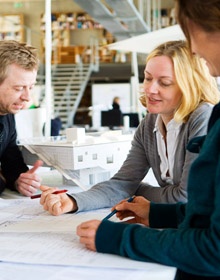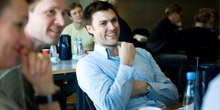Archive
04. november 2011
Research Workshop: Bringing the Building Back In!
Martin Lønborg-Jensen
In mid-November 31 researchers gather at an international research workshop in Denmark. It is arranged by the network Management Studies in the Building Process, and while the Danish context in focus will be the link between researchers and practice, work will continue on the international research network built by Center for Management Studies in the Building Process.
A building is a construction to the extent that it successfully controls for the forces of gravity, a project is an organizational construction to the extent that it maintains a common commitment across the divergent interests and opinions, and a plan is a construction to the extent that it manages to rally trust in its projections and to guide choices of action. But what holds buildings, projects, and plans together, and what alternative mechanisms exist and where are the break points of constructions located?
To initiate a search for ideas about such constructions, and possibly to develop research agendas for the investigation of such constructions, these are the twin projects in the upcoming workshop.
The workshop will cover three interrelated themes: The building as a physical object, the building as friction, and materializations of design. Each theme will be briefly introduced both from a theoretical perspective and illustratively through empirical or imagined vignettes.
A building is a construction to the extent that it successfully controls for the forces of gravity, a project is an organizational construction to the extent that it maintains a common commitment across the divergent interests and opinions, and a plan is a construction to the extent that it manages to rally trust in its projections and to guide choices of action. But what holds buildings, projects, and plans together, and what alternative mechanisms exist and where are the break points of constructions located?
To initiate a search for ideas about such constructions, and possibly to develop research agendas for the investigation of such constructions, these are the twin projects in the upcoming workshop.
The workshop will cover three interrelated themes: The building as a physical object, the building as friction, and materializations of design. Each theme will be briefly introduced both from a theoretical perspective and illustratively through empirical or imagined vignettes.
The functioning and quality of a building
A building is similar to many other physical products in the sense of being a material object, a means of income for people and companies, etc. But while sharing such characteristics with e.g. computer chips, they are also strikingly different in size, in visual transparency, in affordance etc. Assessing the functioning and quality of computer chips requires the enrolment of tools and expertise, while the functioning and quality of a building is subject to immediate visual inspection by also common people, e.g. users and casual observers. This simple observation may easily help us explaining the striking differences in the ways the design and production of chips and buildings are organized.
We suggest that the building should be brought back in, in the form both of a project and an object. By looking at it as a project we acknowledge that it is ‘unfinished’, in formation, under construction … This will bring to the foreground the frictions and restrictions of the building as a projected (imagined) object that emerges in the continuous interplay (competitive as well as collaborative) within a dynamic array of stakeholders.
The aim is to develop a clearer notion of a research agenda in which the special nature of the building as an object of construction, physically, conceptually, and model-wise, could be explored and theorized.
The workshop will take place on 16-18 November 2011 at Magleås Kursuscenter in Høsterkøb.
A building is similar to many other physical products in the sense of being a material object, a means of income for people and companies, etc. But while sharing such characteristics with e.g. computer chips, they are also strikingly different in size, in visual transparency, in affordance etc. Assessing the functioning and quality of computer chips requires the enrolment of tools and expertise, while the functioning and quality of a building is subject to immediate visual inspection by also common people, e.g. users and casual observers. This simple observation may easily help us explaining the striking differences in the ways the design and production of chips and buildings are organized.
We suggest that the building should be brought back in, in the form both of a project and an object. By looking at it as a project we acknowledge that it is ‘unfinished’, in formation, under construction … This will bring to the foreground the frictions and restrictions of the building as a projected (imagined) object that emerges in the continuous interplay (competitive as well as collaborative) within a dynamic array of stakeholders.
The aim is to develop a clearer notion of a research agenda in which the special nature of the building as an object of construction, physically, conceptually, and model-wise, could be explored and theorized.
The workshop will take place on 16-18 November 2011 at Magleås Kursuscenter in Høsterkøb.






